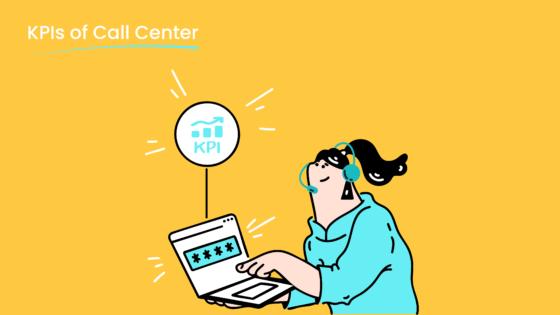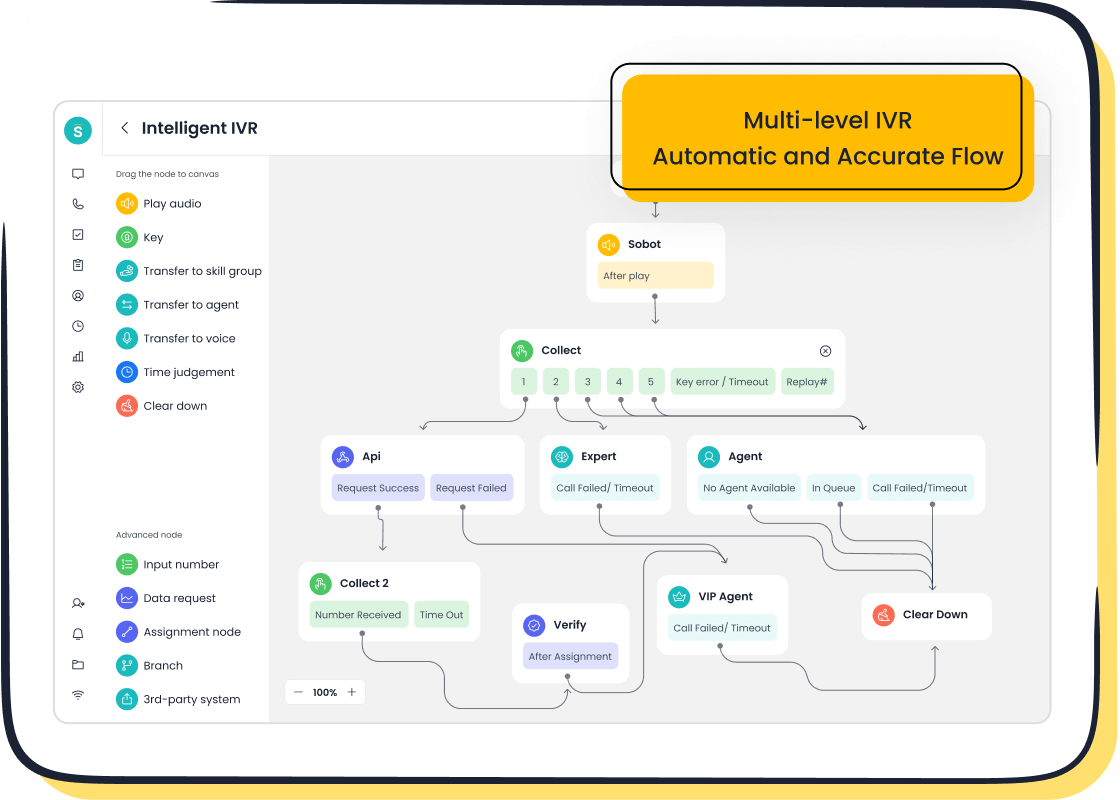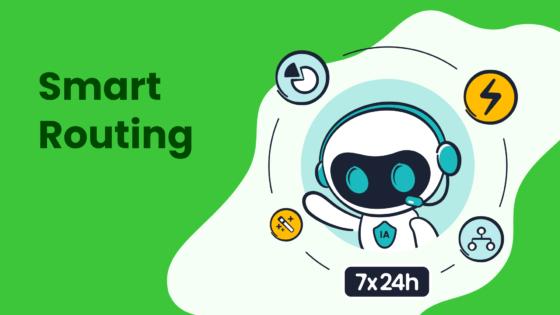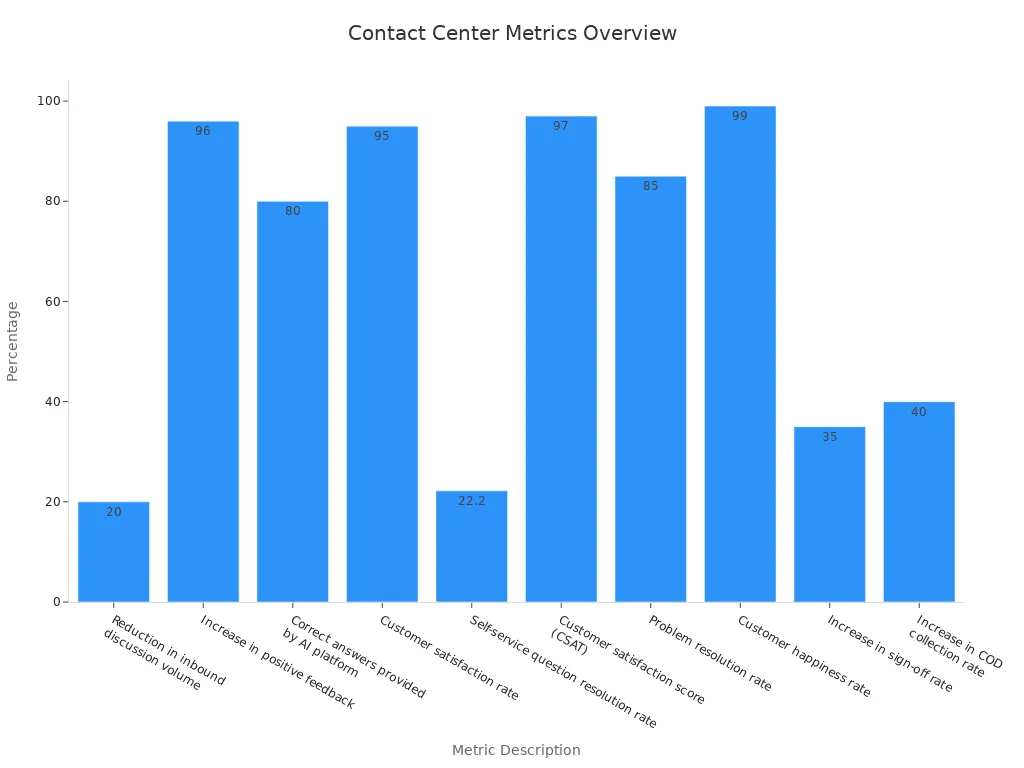Contact Center Metrics Explained: A Practical Guide

Tracking contact center chat metrics transforms customer service operations. It enables you to pinpoint inefficiencies, optimize workflows, and elevate customer experiences. Metrics like First Contact Resolution (FCR) and Customer Satisfaction Score (CSAT) reveal how well your team resolves issues and meets customer expectations. Efficiency metrics, such as Average Handle Time and Agent Utilization Rate, uncover opportunities to improve resource allocation. Technology metrics, including Self-Service Utilization, assess how tools like Sobot enhance operational efficiency through its Voice/Call Center. By leveraging these insights, you can create seamless interactions, reduce costs, and improve satisfaction.
Key Contact Center Metrics to Track

Average Handle Time (AHT): Definition and Importance
Average Handle Time (AHT) measures the total time an agent spends handling a customer interaction, including talk time, hold time, and after-call work. It is one of the most critical contact center metrics for evaluating efficiency. A lower AHT often indicates streamlined processes and well-trained agents, but it should not come at the cost of quality.
For example, in industries like retail and e-commerce, the typical AHT ranges from 2 to 4 minutes, while technical support may see AHTs of 7 to 10 minutes. These benchmarks highlight how AHT varies by industry and service type. Tracking this metric helps you identify bottlenecks in workflows and optimize agent performance.
Tip: Use tools like Sobot's Voice/Call Center to monitor AHT in real time. Features like intelligent IVR and AI-powered voicebots can reduce handle times by automating repetitive tasks.
| Industry | AHT Range (seconds) |
|---|---|
| Service | 426 |
| Sales | 516 |
| Customer Service | 220 (2004) to 426 (2022) |
| Technical Support | 420 (2006) to 600 (2022) |
Reducing AHT without compromising the quality score ensures that your agents resolve issues efficiently while maintaining customer satisfaction. This balance is vital for achieving high call resolution rates and improving overall service quality.
First Call Resolution (FCR): Formula and Industry Standards
First Call Resolution (FCR) measures the percentage of customer issues resolved during the first interaction, without the need for follow-ups. It is a key performance indicator that directly impacts customer satisfaction and operational efficiency. A higher FCR means fewer repeat contacts, which reduces costs and improves the customer experience.
To calculate FCR, use the formula:
FCR (%) = (Total Resolved Cases on First Contact / Total Cases) × 100
Studies show that a 1% increase in FCR correlates with a 1% rise in customer satisfaction scores. Customers who resolve their issues on the first call report satisfaction levels 30% higher than those who require multiple interactions. Conversely, satisfaction drops by 15% each time a customer has to contact you again for the same issue.
- Benefits of tracking FCR:
- Reduces operational costs by minimizing repeat contacts.
- Enhances customer loyalty by resolving issues promptly.
- Improves agent efficiency by reducing workload.
Note: Large organizations, such as utilities, spend over $2.3 million annually on repeat contacts. Improving FCR can significantly cut these costs.

Sobot's Voice/Call Center offers features like smart call routing and unified workspaces to help you achieve higher FCR rates. These tools ensure agents have access to all relevant customer data, enabling them to resolve issues effectively on the first attempt.
Customer Satisfaction Score (CSAT): Measuring Customer Happiness
Customer Satisfaction Score (CSAT) is a direct measure of how happy customers are with your service. It is typically calculated by asking customers to rate their experience on a scale of 1 to 5 or 1 to 10, with higher scores indicating greater satisfaction.
To calculate CSAT, use the formula:
CSAT (%) = (Number of Positive Responses / Total Responses) × 100
CSAT is one of the most important quality metrics for understanding customer sentiment. It provides actionable insights into areas where your service excels and where it needs improvement. For example, a high CSAT often correlates with high first call resolution rates and low average handle times.
| Metric | Importance | Impact on Customer Interactions |
|---|---|---|
| Customer Satisfaction (CSAT) | Directly measures customer happiness and loyalty. | Provides insights into customer loyalty and retention. |
| First Call Resolution (FCR) | Measures the effectiveness of resolving customer issues on the first contact. | Enhances service quality and customer satisfaction. |

Tip: Use Sobot's analytics tools to track CSAT trends over time. These insights can help you align your contact center metrics with broader business goals, such as improving customer loyalty and reducing churn.
By focusing on CSAT, you can ensure that your contact center delivers not just efficient service but also memorable customer experiences. This metric is a cornerstone of any strategy aimed at improving satisfaction and fostering long-term loyalty.
Net Promoter Score (NPS): Understanding Customer Loyalty
Net Promoter Score (NPS) measures how likely your customers are to recommend your business to others. It is a simple yet powerful metric that reflects customer loyalty. To calculate NPS, you ask customers a single question: "On a scale of 0 to 10, how likely are you to recommend us to a friend or colleague?" Based on their responses, customers fall into three categories:
- Promoters (9-10): Loyal customers who actively promote your brand.
- Passives (7-8): Satisfied but not enthusiastic customers.
- Detractors (0-6): Unhappy customers who may harm your reputation through negative feedback.
The formula for NPS is straightforward:
NPS = % of Promoters - % of Detractors
While NPS is widely used, studies suggest it should not be the sole indicator of customer loyalty. For instance, research by Keiningham et al. (2007) and Morgan and Rego (2006) highlights that NPS alone cannot reliably predict growth or performance. Zaki et al. (2016) emphasize the need for a multidimensional approach to better understand customer loyalty.
| Study | Findings |
|---|---|
| Keiningham et al. (2007) | NPS is not the sole reliable indicator of a company's growth potential. |
| Pingitore et al. (2007) | No clear correlation between NPS and changes in revenue. |
| Morgan and Rego (2006) | NPS scores alone cannot reliably predict intention-to-recommend. |
| Zaki et al. (2016) | A single-question metric like NPS is limited in predicting loyalty. |
To maximize the value of NPS, combine it with other contact center metrics like Customer Satisfaction Score (CSAT) and First Call Resolution (FCR). Tools like Sobot's Voice/Call Center can help you track NPS trends and integrate them with other performance indicators. This holistic approach ensures you gain deeper insights into customer loyalty and satisfaction.
Contact Center Chat Metrics: Metrics for Chat-Based Interactions
Chat-based interactions are becoming increasingly popular in contact centers. Tracking chat-specific metrics helps you evaluate the efficiency and quality of your chat support. Key metrics include:
- First Response Time (FRT): Measures how quickly agents respond to a customer's initial message. Faster response times improve customer satisfaction.
- Chat Duration: Tracks the total time spent on a chat session. Shorter durations often indicate efficient issue resolution.
- Customer Satisfaction (CSAT): Evaluates customer happiness with the chat experience.
- Chat-to-Call Ratio: Compares the number of chats to calls. A higher ratio suggests customers prefer chat for support.
These metrics provide valuable insights into your chat operations. For example, monitoring FRT helps you identify delays and optimize agent workflows. Similarly, tracking chat duration ensures agents resolve issues efficiently without rushing customers.
Sobot's Omnichannel Solution simplifies chat metric tracking by consolidating data from multiple channels into a unified workspace. This integration allows you to analyze trends, improve agent performance, and enhance the overall customer experience. By focusing on these metrics, you can ensure your chat support meets customer expectations and aligns with your business goals.
Call Abandonment Rate: Impact on Customer Experience
Call abandonment rate measures the percentage of customers who hang up before speaking to an agent. It is a critical metric that directly impacts customer experience. A high abandonment rate often indicates long hold times or inefficient call routing.
The average call abandonment rate in global contact centers was 6.44% in 2021, according to the Talkdesk Global Contact Center KPI Benchmarking Report. Long hold times make customers feel unappreciated, leading to frustration and a loss of trust in your organization.
Key factors contributing to high abandonment rates include:
- Extended Hold Times: Customers are less likely to wait if they perceive the wait time as excessive.
- Poor Call Routing: Inefficient routing increases wait times and abandonment rates.
- Lack of Self-Service Options: Customers may abandon calls if they cannot resolve issues independently.
Reducing abandonment rates improves customer satisfaction and loyalty. Sobot's Voice/Call Center offers features like intelligent IVR and smart call routing to minimize hold times and ensure customers reach the right agent quickly. These tools help you create a seamless experience, reducing frustration and enhancing trust.
By addressing the causes of high abandonment rates, you can improve your contact center's efficiency and deliver a better customer experience. Tracking this metric alongside other contact center metrics ensures you maintain a balanced approach to performance management.
Agent Utilization and Occupancy Rate: Optimizing Workforce Efficiency
Agent utilization and occupancy rate are two critical contact center metrics that directly impact workforce efficiency. Understanding these metrics helps you optimize your team's performance and ensure resources are used effectively.
What Is Agent Utilization?
Agent utilization measures the percentage of time your agents spend actively supporting customers compared to their total available time. This metric provides a clear picture of how much of your workforce's capacity is being used for productive tasks. For example, if an agent works an 8-hour shift and spends 6 hours handling customer interactions, their utilization rate is 75%.
A high utilization rate indicates that your agents are consistently engaged in meaningful work. However, overutilization can lead to burnout and reduced service quality. Striking the right balance is essential for maintaining both productivity and employee well-being.
What Is Occupancy Rate?
Occupancy rate focuses on the proportion of time agents spend on support activities, such as answering calls or responding to chats, compared to non-support activities like breaks or training. For instance, if an agent spends 7 hours of their 8-hour shift on support tasks, their occupancy rate is 87.5%.
This metric highlights how effectively your agents' time is being allocated. A high occupancy rate suggests efficient scheduling and workload distribution. However, like utilization, excessively high occupancy can negatively affect morale and performance.
Why These Metrics Matter
Tracking agent utilization and occupancy rate allows you to identify inefficiencies and improve call center productivity. These metrics help you answer key questions, such as:
- Are your agents spending too much time on non-productive tasks?
- Is your team overworked, leading to burnout?
- Are you scheduling the right number of agents to meet demand?
By addressing these questions, you can create a balanced workload that maximizes productivity while maintaining a positive work environment.
How to Optimize These Metrics
Improving agent utilization and occupancy rate requires a strategic approach. Here are some actionable steps:

- Leverage Technology: Use tools like Sobot's Voice/Call Center to monitor these metrics in real time. Features such as smart call routing and AI-powered voicebots can reduce idle time and ensure agents focus on high-priority tasks.
- Streamline Processes: Automate repetitive tasks to free up agents for more complex interactions. This not only boosts productivity but also enhances job satisfaction.
- Optimize Scheduling: Analyze historical data to predict call volumes and schedule agents accordingly. This ensures you have enough staff during peak hours without overstaffing during quieter periods.
- Provide Training: Equip your agents with the skills they need to handle customer interactions efficiently. Well-trained agents can resolve issues faster, improving both utilization and occupancy rates.
The Bigger Picture
Agent utilization and occupancy rate are more than just numbers. They are indicators of your contact center's overall health and efficiency. By optimizing these metrics, you can improve contact center productivity, reduce costs, and enhance the customer experience. Remember, the importance of call center productivity lies in its ability to drive better outcomes for both your business and your customers.
Tip: Regularly review these metrics alongside others like Average Handle Time (AHT) and First Call Resolution (FCR). This holistic approach ensures your contact center operates at peak efficiency.
Real-World Impact
Research confirms that improving these metrics leads to tangible benefits:
- Occupancy: Measures how effectively agents' time is utilized, ensuring minimal idle periods.
- Agent Utilization Rate: Reflects the percentage of time agents actively support customers, directly influencing workforce efficiency.
By focusing on these metrics, you can create a more productive and engaged workforce. Tools like Sobot's Voice/Call Center provide the insights you need to make data-driven decisions, helping you achieve your operational goals.
How to Calculate Contact Center Metrics
Formulas for Key Metrics
Understanding the formulas behind contact center metrics helps you measure performance accurately. These formulas provide a quantifiable way to assess your team's strengths and weaknesses. Here are some essential ones:
-
Average Handle Time (AHT):
(Talk Time + Hold Time + After-Call Work) ÷ Total Number of Calls
This formula helps you evaluate how efficiently your agents handle interactions. -
First Call Resolution (FCR):
(Resolved Cases on First Contact ÷ Total Cases) × 100
Use this to determine the percentage of issues resolved in the first interaction. -
Call Abandonment Rate:
(Abandoned Calls ÷ Total Incoming Calls) × 100
This metric highlights how often customers hang up before reaching an agent.
These formulas are widely used in the industry because they provide reliable insights into operational efficiency. Studies have identified 11 key metrics, including these, as essential for evaluating agent performance and improving workflows.
Examples of Metric Calculations
Real-world examples demonstrate how these formulas work in practice. For instance:
| Company | Metric | Result |
|---|---|---|
| American Express | Call Abandonment Rate | Reduced to 2% |
| Delta Airlines | Virtual Queuing | Customers can request callbacks |
| Apple | Customer Satisfaction Score (CSAT) | Achieves scores above 95% |
| Netflix | Customer Satisfaction | Maintains high satisfaction through 24/7 support across multiple channels |
These examples show how companies use metrics to enhance customer experiences. For example, reducing call abandonment rates improves trust, while high CSAT scores reflect exceptional service quality.
Ensuring Accurate Data Collection with Sobot's Voice/Call Center

Accurate data collection is the foundation of reliable metrics. Sobot's Voice/Call Center simplifies this process with features like real-time monitoring and intelligent IVR. These tools ensure you capture every interaction detail, from call durations to resolution rates.
The platform also integrates seamlessly with CRM systems, consolidating customer data into a unified workspace. This integration eliminates data silos, enabling you to calculate metrics like AHT and FCR with precision. By leveraging Sobot's analytics, you can learn how to calculate call center productivity effectively and make data-driven decisions to optimize performance.
Tip: Use Sobot's smart call routing to reduce abandoned calls and improve FCR. These features help you maintain high service standards while streamlining operations.
How to Analyze Contact Center Metrics
Identifying Trends and Patterns in Data
Analyzing trends and patterns in your contact center data helps you uncover valuable insights into customer behavior and operational efficiency. By examining historical data, you can identify recurring issues, predict future challenges, and take proactive measures to improve performance.
- Review past call data to forecast incoming call volumes. This allows you to prepare your team for peak periods and avoid long wait times.
- Analyze the types of questions customers frequently ask. This helps you refine your self-service options and train agents to handle common inquiries more effectively.
- Monitor customer behavior to anticipate when they might consider leaving your service. Early intervention can help you retain customers and build loyalty.
| Type | Description |
|---|---|
| Descriptive | Analyzes historical data to understand past performance metrics like call volumes and customer satisfaction scores. |
| Predictive | Uses data models to forecast future outcomes, such as call volume spikes and customer churn risks. |
| Prescriptive | Recommends actions based on predictive insights to optimize staffing and customer service strategies. |
Kory Lawszewski, vice president of global sales at TELUS Digital, highlights the importance of analyzing customer interactions across multiple channels. This approach helps you pinpoint pain points and refine your service strategies. Tools like Sobot's Voice/Call Center simplify this process by providing real-time data analysis and predictive insights. These features enable you to make informed decisions that enhance customer experience and operational efficiency.
Tip: Use predictive analytics to anticipate customer needs and allocate resources effectively. This ensures your team is always prepared to deliver exceptional service.
Linking Metrics to Business Goals
Contact center metrics should align with your broader business objectives. Metrics like call center performance metrics not only measure success but also guide your progress toward achieving key goals. For example, improving First Call Resolution (FCR) directly impacts customer satisfaction, which in turn boosts customer loyalty and retention.
- Metrics should predict and guide progress toward business goals. For instance, tracking Net Promoter Score (NPS) helps you gauge customer loyalty and identify areas for improvement.
- Ownership and accountability are essential. Assigning responsibility for specific metrics ensures your team remains focused on achieving targets.
- A well-rounded set of metrics defines and measures progress. Combining efficiency metrics like Average Handle Time (AHT) with quality metrics like Customer Satisfaction Score (CSAT) provides a comprehensive view of your performance.
Sobot's Voice/Call Center integrates seamlessly with your existing systems, enabling you to link metrics to business goals effortlessly. By consolidating data into a unified workspace, you can track progress, identify gaps, and implement strategies that drive performance improvement.
Note: Regularly review your metrics to ensure they remain aligned with your evolving business objectives. This proactive approach keeps your contact center on track to achieve its goals.
Using Metrics to Improve Agent Performance
Metrics play a crucial role in enhancing agent performance. By analyzing trends in agent activity, you can identify areas for improvement and implement targeted strategies to boost efficiency and effectiveness.
| Evidence Type | Description |
|---|---|
| Performance Improvement | Call centers that implement structured coaching programs based on performance data can see up to a 30% improvement in key performance indicators (KPIs) within three months. |
| Actionable Strategies | Analyzing trends in agent performance helps businesses optimize workflows and improve training materials, leading to more efficient operations. |
| Technology Integration | Utilizing AI-driven real-time coaching bots and predictive models enhances agent performance and customer satisfaction. |
Start by reviewing metrics like AHT and FCR to identify bottlenecks in workflows. For example, if an agent consistently struggles with long handle times, additional training or process adjustments may be necessary. Structured coaching programs based on performance data can lead to significant improvements in key metrics within a short period.
AI-driven tools like Sobot's Voice/Call Center offer real-time coaching and predictive insights. These features empower agents to resolve issues more efficiently, enhancing both their performance and the overall customer experience. By leveraging these tools, you can create a supportive environment that fosters continuous growth and development.
Callout: Investing in your agents' success benefits your entire organization. Well-trained and motivated agents deliver better service, leading to higher customer satisfaction and loyalty.
Enhancing Customer Experience Through Insights
Improving customer experience starts with understanding the data your contact center collects. Metrics like Net Promoter Score (NPS), Customer Satisfaction Score (CSAT), and First Call Resolution (FCR) reveal patterns in customer behavior and service quality. By analyzing these insights, you can identify areas for improvement and implement strategies that enhance satisfaction.
How Insights Drive Better Experiences
Insights derived from metrics help you pinpoint inefficiencies and refine processes. For example, tracking NPS allows you to measure customer sentiment and detect changes that negatively impact satisfaction. Bonobos used NPS to identify a process change that caused dissatisfaction. By rolling back the change, they avoided further issues and maintained customer loyalty.
Similarly, Glassdoor expanded its feedback collection using NPS to gain a broader view of customer experiences. This approach led to diverse product feedback, enabling targeted service improvements. Koçtaş implemented AI-driven strategies based on customer insights, achieving a 60% increase in NPS and reducing complaints by 20%. These examples highlight how actionable insights can transform customer interactions.
| Company | Evidence of Improvement | Outcome |
|---|---|---|
| Bonobos | Used NPS to measure customer sentiment and identified a negative impact from a process change. | Rolled back the change based on NPS feedback, avoiding customer dissatisfaction. |
| Glassdoor | Expanded feedback collection using NPS to gain a comprehensive view of customer experience. | Achieved more diverse product feedback, leading to better service improvements. |
| Koçtaş | Implemented AI-driven CX strategies, resulting in a 60% NPS increase and reduced complaints. | Enhanced customer loyalty and satisfaction through proactive issue resolution. |
Practical Steps to Leverage Insights
To enhance customer experience, focus on these actionable steps:
- Analyze Trends: Review historical data to identify recurring issues. For example, if customers frequently complain about long wait times, consider optimizing call routing or adding self-service options.
- Refine Processes: Use insights to streamline workflows. Automating repetitive tasks frees agents to focus on complex issues, improving both efficiency and satisfaction.
- Personalize Interactions: Metrics like CSAT and NPS provide a deeper understanding of customer preferences. Use this data to tailor your service, making interactions more meaningful.
Sobot's Voice/Call Center simplifies this process by offering real-time analytics and predictive insights. These tools help you monitor trends, refine strategies, and deliver personalized experiences that exceed expectations.
The Impact of Data-Driven Decisions
When you use insights to guide your decisions, the results speak for themselves. Improved customer experience leads to higher satisfaction, stronger loyalty, and better retention rates. Metrics like NPS and CSAT act as benchmarks, showing you where your service excels and where it needs improvement. By continuously analyzing and acting on these insights, you create a contact center that prioritizes customer happiness.
Tip: Regularly review your metrics to ensure your strategies align with customer needs. This proactive approach keeps your service relevant and effective.
Common Challenges and Solutions
Addressing Inconsistent Data Collection
Inconsistent data collection can disrupt your ability to measure performance accurately. It often stems from overwhelming data provided by QA software, which can lead to misinterpretation. Quality analysts typically review only 1-2% of calls, leaving many compliance issues unnoticed. Additionally, inconsistent evaluation standards across assessors create discrepancies in scoring, which can affect agent morale.
To overcome these challenges, you should establish clear definitions for key metrics. This ensures everyone on your team understands what they are measuring. Regularly reviewing data collection processes helps you identify weaknesses and correct them. Training your staff on data literacy empowers them to analyze reports accurately and derive meaningful insights. Structured approaches to data collection, combined with real-time data capture methods, enhance service quality and ensure reliable reporting.
Tip: Use tools like Sobot's Voice/Call Center to integrate real-time data capture into your operations. This ensures you collect accurate and actionable insights for improving customer interactions.
Avoiding Overemphasis on Single Metrics
Focusing too heavily on one metric can distort your understanding of overall performance. For example, prioritizing Average Handle Time (AHT) might lead agents to rush through calls, compromising service quality. A single metric cannot provide a comprehensive view of your contact center's effectiveness or your employees' contributions.
To avoid this pitfall, balance efficiency metrics like AHT with quality-focused metrics such as Customer Satisfaction Score (CSAT). This approach ensures you evaluate both operational efficiency and customer happiness. Combining multiple metrics gives you a holistic view of your contact center's performance, helping you make informed decisions.
Note: Sobot's analytics tools allow you to track a variety of metrics simultaneously, ensuring you maintain a balanced perspective on performance.
Generating Actionable Insights from Data
Turning raw data into actionable insights requires a strategic approach. Start by gathering data from various sources, such as call transcripts and customer feedback. Analyze this information to identify patterns and trends. For example, speech analytics can reveal common customer concerns, while text analytics uncovers sentiment in written communications.
Once you identify key themes, translate them into specific recommendations. Align these insights with your organizational goals and involve stakeholders in implementing changes. Advanced analytics tools, like those offered by Sobot, simplify this process by providing real-time insights into customer behavior and pain points.
| Type of Analytics | Purpose | Benefits |
|---|---|---|
| Speech Analytics | Transforms voice interactions into actionable insights | Identifies customer concerns and coaching opportunities |
| Text Analytics | Analyzes written communications to uncover patterns | Improves response quality and tracks customer sentiment |
| Agent Performance Analytics | Tracks metrics and qualitative assessments of agent performance | Recognizes top performers and identifies training opportunities |
| Customer Journey Analytics | Provides insights into customer navigation through contact center channels | Spots friction points and streamlines customer workflows |
By leveraging these tools, you can enhance service quality and improve customer satisfaction. This data-driven approach ensures your contact center operates efficiently while meeting customer needs.
Balancing Efficiency with Customer Satisfaction
Balancing efficiency with customer satisfaction requires thoughtful strategies that prioritize both operational goals and customer needs. You can achieve this balance by leveraging technology and empowering your team to deliver exceptional service.
Strategies to Balance Efficiency and Satisfaction
- Strategic Channel Allocation: Use AI for channels like web chat and SMS, where customers prefer quick responses. Reserve human agents for phone calls and social media to handle complex or emotional interactions.
- Seamless Escalation: Ensure AI systems recognize when a customer needs human assistance. Transfer them to an agent without requiring them to repeat their issue.
- Feedback Collection: Regularly gather customer feedback on AI interactions. Use these insights to refine your system and improve user experiences.
- Transparency and Choice: Inform customers when they are interacting with AI. Offer them the option to switch to a human agent easily.
- AI Training and Optimization: Invest in advanced AI systems that understand context and complex queries. This reduces frustration and improves resolution rates.
- Human Agent Empowerment: Equip agents with the tools and knowledge to handle escalations effectively. Empathy and expertise enhance customer satisfaction.
Why This Matters
Efficiency ensures your team handles high volumes of interactions without delays. Satisfaction builds trust and loyalty, which are essential for long-term success. When you focus on both, you create a contact center that meets customer expectations while maintaining operational excellence.
Tip: Use tools like Sobot's Voice/Call Center to implement these strategies. Features like smart call routing and AI-powered voicebots streamline workflows and improve customer experiences.
By combining technology with human expertise, you can optimize your operations and deliver service that delights your customers. This approach ensures your contact center remains efficient while fostering strong relationships with your audience.
Tools and Technologies for Tracking Metrics

Sobot's Voice/Call Center: Features and Benefits
Sobot's Voice/Call Center offers a comprehensive solution for tracking and improving contact center metrics. Its advanced features, such as intelligent IVR and AI-powered voicebots, streamline operations and enhance customer interactions. By automating repetitive tasks, the platform reduces inbound discussion volume by 20% and increases the accuracy of answers provided by AI to 80%. These improvements directly impact customer satisfaction, which can reach rates as high as 97%.
The platform also excels in self-service capabilities, resolving 22.2% of customer queries without agent intervention. This not only improves efficiency but also boosts customer happiness to an impressive 99%. Businesses using Sobot's Voice/Call Center report a 35% increase in sign-off rates and a 40% rise in COD collection rates, showcasing its ability to drive tangible results.
| Metric Description | Value |
|---|---|
| Reduction in inbound discussion volume | 20% |
| Increase in positive feedback | 96% + |
| Correct answers provided by AI platform | 80% |
| Customer satisfaction rate | 95% |
| Self-service question resolution rate | 22.2% |
| Customer happiness rate | 99% |
| Problem resolution rate | 85% |
| Increase in sign-off rate | 35% |
| Increase in COD collection rate | 40% |

By leveraging these features, you can optimize your contact center's performance and deliver exceptional customer experiences.
Real-Time Dashboards for Performance Monitoring
Real-time dashboards play a crucial role in performance monitoring by providing instant access to key metrics. These dashboards allow you to track call response times, customer satisfaction, and other critical indicators without delay. Real-time monitoring enables quick identification of trends and anomalies, helping you take immediate corrective actions.
Businesses using real-time dashboards report up to a 30% improvement in operational efficiency. Supervisors can use live data to address issues like response time lags or resource shortages. For example, proactive coaching becomes easier when you can monitor agent performance in real time. Managers can also redirect resources based on live insights, ensuring optimal workload distribution.
| Evidence | Description |
|---|---|
| Real-time monitoring | Enables quick identification of trends and anomalies for immediate action. |
| Key performance indicators | Evaluates metrics like call response times and customer satisfaction. |
| Operational efficiency improvement | Enhances efficiency by up to 30%. |
| Proactive coaching | Allows supervisors to address issues instantly. |
| Resource redirection | Adjusts resources based on live data insights. |
With Sobot's Voice/Call Center, you gain access to real-time dashboards that transform your contact center operations. These tools empower you to monitor performance effectively and make data-driven decisions.
AI and Predictive Analytics for Insights
AI and predictive analytics have revolutionized how contact centers operate. By analyzing historical data, these technologies forecast future trends and customer needs. For instance, a leading health and wellness company implemented automation technology, resulting in an 18.4% increase in agent productivity. They also reduced idle time by over 14 hours per month per associate, achieving a 15.9x return on investment.
Predictive analytics helps you anticipate call volumes, enabling better resource allocation. AI-powered tools, like those in Sobot's Voice/Call Center, enhance decision-making by identifying patterns in customer behavior. These insights allow you to refine workflows, improve agent training, and deliver personalized customer experiences.
Tip: Use AI-driven analytics to predict customer needs and optimize your contact center's performance. This proactive approach ensures you stay ahead of challenges and maintain high service standards.
Integration with CRM and Omnichannel Solutions
Integrating your contact center with CRM and omnichannel solutions transforms how you manage customer interactions. It creates a unified system that connects customer data, communication channels, and workflows. This integration ensures your team delivers personalized and efficient service.
Benefits of CRM Integration
CRM systems store customer data, including purchase history, preferences, and past interactions. When you integrate CRM with your contact center, agents access this information instantly. This improves issue resolution and enhances customer satisfaction.
Key advantages include:
- Personalized Service: Agents tailor responses based on customer history.
- Faster Resolutions: Access to detailed records reduces repetitive questioning.
- Improved Collaboration: Teams share insights across departments seamlessly.
Tip: Sobot's Voice/Call Center integrates with popular CRM platforms like Salesforce and HubSpot. This simplifies data sharing and boosts efficiency.
Omnichannel Solutions for Seamless Communication
Omnichannel solutions unify communication channels such as voice, email, chat, and social media. Customers interact with your business through their preferred medium without losing context. This approach ensures consistent service across all platforms.
| Feature | Benefit |
|---|---|
| Unified Workspace | Agents manage interactions from multiple channels in one place. |
| AI-Driven Insights | Predictive analytics improve customer experience. |
| Channel Flexibility | Customers switch between channels without repeating information. |
Sobot's Omnichannel Solution consolidates customer data and interactions into a single workspace. It supports proactive insights, enabling you to optimize workflows and improve service quality.
Why Integration Matters
Integrated systems reduce inefficiencies and improve customer satisfaction. They empower agents with the tools and data needed to deliver exceptional service. By combining CRM and omnichannel solutions, you create a contact center that meets customer needs while achieving operational excellence.
Callout: Use Sobot's solutions to streamline your operations and deliver seamless customer experiences.
Tracking contact center metrics transforms your operations and enhances customer satisfaction. Metrics like CSAT and NPS reveal customer perceptions, while AHT and FCR measure agent productivity. Operational metrics, such as call volume and churn rate, optimize staffing and reduce unresolved issues.
| Metric Type | Key Metrics (Examples) | Importance for Performance and Satisfaction |
|---|---|---|
| Customer Satisfaction | CSAT, NPS | Provides insights into customer perceptions and experiences. |
| Agent Productivity | AHT, FCR | Measures efficiency and effectiveness of agents. |
| Operational Efficiency | Call Volume, Churn Rate | Helps optimize staffing and address unresolved customer issues. |

Leverage tools like Sobot's Voice/Call Center to monitor these metrics effectively. Its intelligent IVR and real-time dashboards simplify tracking, ensuring your contact center delivers exceptional service.
FAQ
What are the most important contact center metrics to track?
Focus on metrics like Average Handle Time (AHT), First Call Resolution (FCR), Customer Satisfaction Score (CSAT), and Net Promoter Score (NPS). These metrics help you measure efficiency, customer happiness, and loyalty, ensuring your contact center delivers exceptional service.
How can Sobot's Voice/Call Center improve my contact center metrics?
Sobot's Voice/Call Center offers tools like intelligent IVR, AI-powered voicebots, and real-time dashboards. These features streamline workflows, reduce handle times, and improve resolution rates. You can track metrics accurately and optimize performance using its advanced analytics.
Why is First Call Resolution (FCR) critical for customer satisfaction?
FCR ensures customers resolve their issues during the first interaction. Higher FCR rates reduce repeat contacts, save time, and boost customer satisfaction. Customers feel valued when their problems are solved quickly and efficiently.
How do real-time dashboards help in performance monitoring?
Real-time dashboards provide instant access to metrics like response times and customer satisfaction. You can identify trends, address issues immediately, and optimize resource allocation. This improves operational efficiency and enhances customer experience.
Can I integrate Sobot's solutions with my existing CRM system?
Yes! Sobot's Voice/Call Center integrates seamlessly with CRM platforms like Salesforce and HubSpot. This allows you to access customer data instantly, personalize interactions, and improve resolution rates without switching systems.
See Also
Essential Strategies for Effective Call Center Quality Management
Comprehensive Overview of Call Center Quality Management Systems
Enhancing Call Center Efficiency Through Effective Monitoring Techniques
